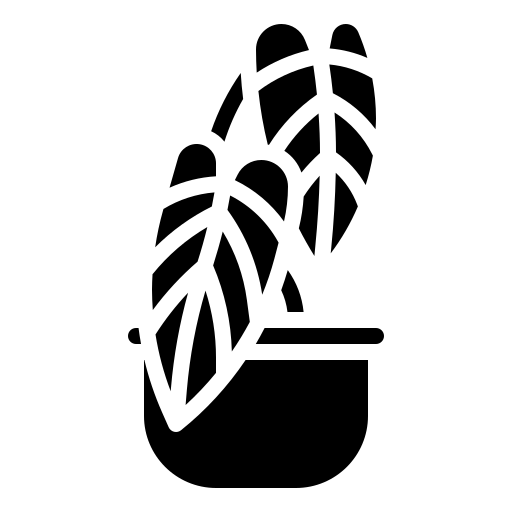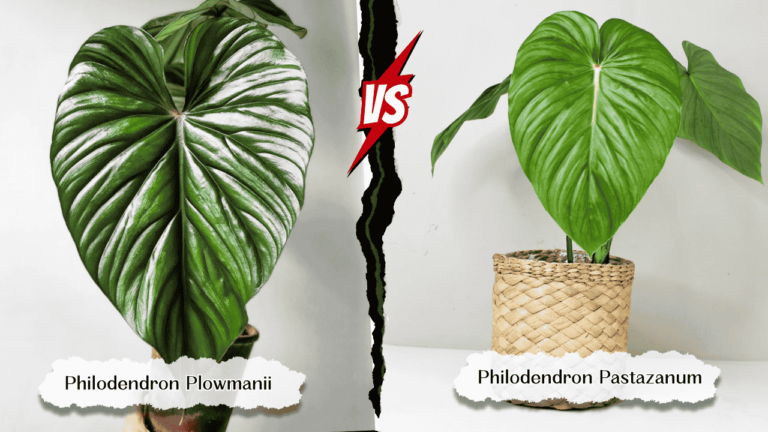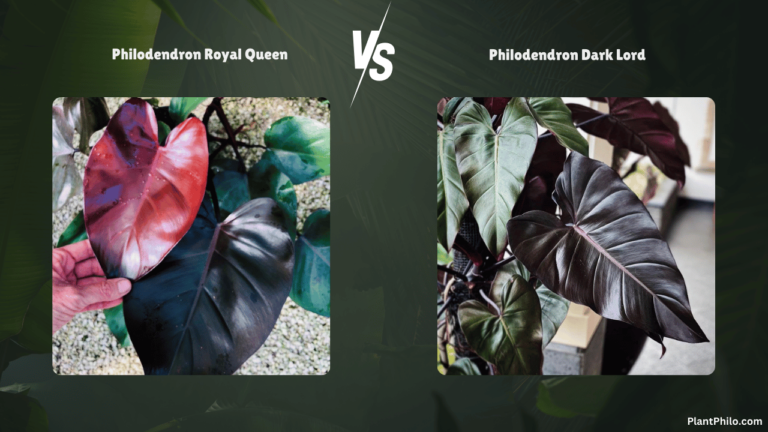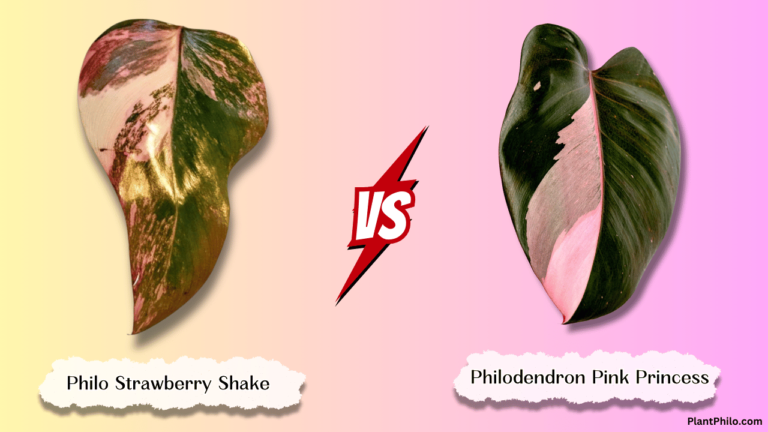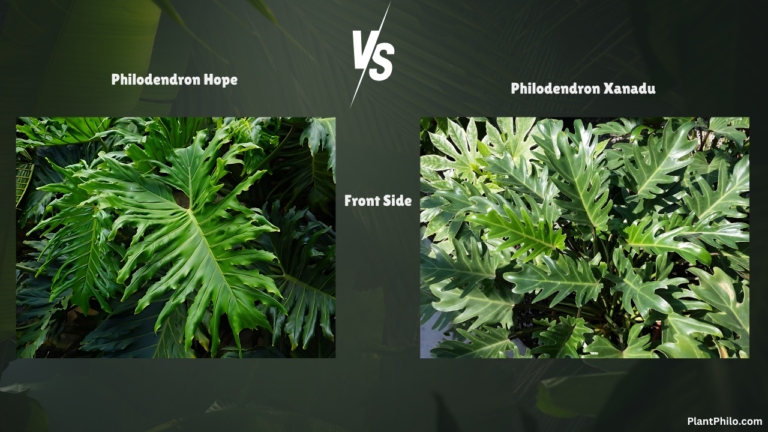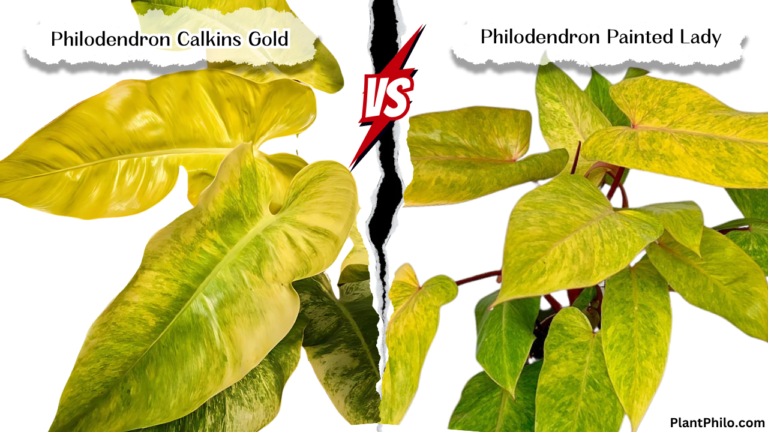Don’t Be Stumped! Know the Differences Between Philodendron Tortum & Elegans
Philodendron Tortum or Elegans? It’s like standing before two exquisite tapestries, each with its own intricate patterns and textures. Choosing between these two vining wonders can leave plant enthusiasts in a state of delightful bewilderment.
But fear not, fellow green thumbs! Let’s embark on a journey through the delicate details of these two climbers, ensuring you pick the perfect leafy masterpiece to adorn your indoor jungle.
Comparison Table: Philodendron Tortum vs. Elegans
| Feature | Philodendron Tortum | Philodendron Elegans |
| Botanical Name | Philodendron tortum | Philodendron elegans |
| Common Names | Bird’s Nest Philodendron, Skeleton Key Philodendron | Skeleton Key Philodendron, Lacy Tree Philodendron |
| Origin | Southern Mexico to Panama | Colombia & Ecuador |
| Growth Habit | Vining, climbing with support, can become shrub-like with age | Vining, climbing with support |
| Leaf Shape & Size | Deeply pinnatifid, bird’s foot-shaped, up to 12 inches long | Deeply pinnatifid, finger-like lobes, up to 24 inches long |
| Color | Deep green | Deep green |
| Light Requirements | Bright, indirect light for optimal growth; tolerates some shade but growth may slow | Bright, indirect light; tolerates some shade |
| Watering Needs | Water when top 2-3 inches of soil are dry | Water when top 2-3 inches of soil are dry |
| Humidity | Appreciates higher humidity but tolerates average levels with extra care | Appreciates higher humidity but tolerates average levels with extra care |
| Fertilizing | Balanced liquid fertilizer diluted to half-strength, monthly during growing season | Balanced liquid fertilizer diluted to half-strength, monthly during growing season |
| Common Pests & Diseases | Mealybugs, scale, spider mites | Mealybugs, scale, spider mites |
| Propagation | Stem cuttings or air layering | Stem cuttings or air layering |
| Toxicity | Toxic to pets and humans if ingested | Toxic to pets and humans if ingested |
| Petiole | Long, slender, often reddish | Long, slender, green |
| Stem | Thin, vining, develops aerial roots | Thin, vining, develops aerial roots |
| New Leaf Color | Lighter green, maturing to deep green | Lighter green, maturing to deep green |
| Air Purifying | Moderate air purifying qualities | Moderate air purifying qualities |
| Overall Difficulty | Moderately challenging to care for | Moderately easy to care for |
| Mature Size | Can reach 6-8 feet with support, can become shrub-like with age | Can reach 10-15 feet with support |
In-Depth Comparison
Leaf Shape & Size
Both the Tortum and Elegans showcase deeply pinnatifid leaves, creating a sense of airiness and visual intrigue. It’s like having a piece of living art in your home.
The Tortum, however, has leaves that resemble a bird’s foot, with broader lobes that create a denser, more compact appearance. The Elegans, on the other hand, have narrower, finger-like lobes that give them a more delicate, lacy look.
Growth Habit: Climbing vs. Sprawling
Both plants are natural climbers, eager to ascend toward the light with the help of a moss pole or trellis. The Tortum, however, has a unique characteristic – as it matures, it can develop a shrub-like habit, branching out and creating a fuller, denser appearance.
The Elegans, in contrast, maintain their vining habit throughout their lives, reaching impressive lengths with their cascading foliage.
Color
Both the Tortum and Elegans showcase a deep, rich green hue that evokes a sense of tranquility and connection to nature. The Tortum’s leaves often have a slightly darker green coloration, while the Elegans’ leaves might exhibit a subtle sheen, reflecting light and adding a touch of vibrancy.
Light & Water
Both plants thrive in bright, indirect light, which helps them maintain their lush green color and encourages healthy growth. While they can tolerate some shade, their growth might slow down, and their leaves might become less vibrant.
Avoid direct sunlight, as it can scorch their delicate foliage. When it comes to watering, both plants prefer their soil to dry out slightly between waterings. Allow the top 2-3 inches of soil to dry out before reaching for your watering can.
Humidity
Hailing from tropical regions, both plants appreciate a humid environment. Think of it as their way of staying connected to their roots.
While they can tolerate average household humidity, they’ll express their gratitude with lusher growth and healthier leaves if you can bump up the moisture levels. Misting, pebble trays, or a humidifier can all work wonders.
Fertilizing, Pests & Propagation
Both plants benefit from a monthly dose of diluted liquid fertilizer during their growing season. They’re also susceptible to the same common houseplant pests, such as mealybugs, scale, and spider mites. Vigilance and prompt treatment are key to keeping these pests at bay. Both the Tortum and Elegans can be propagated through stem cuttings or air layering.
Toxicity: A Word of Caution
While these plants are visually stunning, they’re not meant for consumption. Both contain calcium oxalate crystals, which can cause irritation and swelling if ingested. Keep them out of reach of pets and curious children.
Overall Difficulty & Mature Size: Planning for Growth
The Tortum, with its unique growth habit and slightly higher sensitivity to environmental changes, can be a bit more challenging to care for than the Elegans. However, with a little extra attention and understanding, it will reward you with its captivating beauty. The Elegans, on the other hand, is generally considered moderately easy to care for, making it a great choice for plant enthusiasts of various skill levels.
In terms of mature size, the Elegans take the lead, reaching an impressive 10-15 feet with support. The Tortum, while still a climber, tends to be more compact, reaching 6-8 feet with support and potentially developing a shrub-like habit as it matures.
FAQs: Addressing Your Queries
Which plant is better for small spaces?
The Philodendron Tortum, especially if it develops a shrub-like habit, might be a better fit for smaller spaces.
Which plant is faster growing?
The Philodendron Elegans generally grow faster than the Tortum.
Can I prune these plants?
Yes, you can prune both to manage their size and shape or encourage bushier growth in the Tortum
Do these plants flower?
They rarely flower indoors.
What type of soil is best?
A well-draining potting mix rich in organic matter.
How often should I repot?
Repot every 2-3 years or when roots become overcrowded.
Can I grow them outdoors?
Yes, in warm climates, but it provides protection from harsh sunlight.
Which plant is more expensive?
The Philodendron Tortum is generally rarer and can be more expensive than the Elegans.
Why are the leaves on my plant turning yellow?
This could indicate overwatering, underwatering or nutrient deficiencies.
How can I encourage my plants to climb?
Provide them with a moss pole or trellis and gently guide their vines upwards.
Which one Will You Choose?
Choosing between the Philodendron Tortum and Elegans is a delightful decision, like picking between two unique works of art. If you’re captivated by intricate foliage and the potential for a shrub-like habit, the Tortum might be your ideal choice. If you prefer a graceful climber with delicate, lacy leaves, the Elegans will surely enchant you.
Remember, both plants bring a touch of tropical elegance and airiness to any space. With proper care and attention, they’ll reward you with their stunning foliage for years to come.
